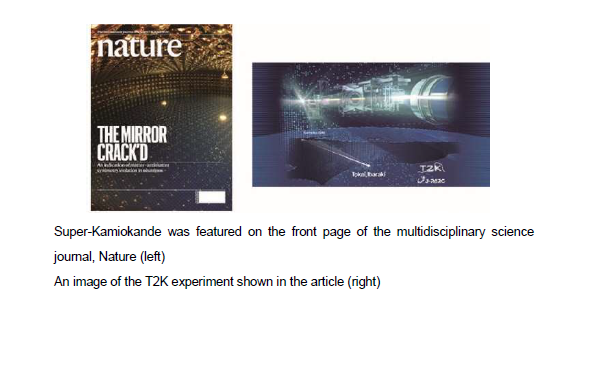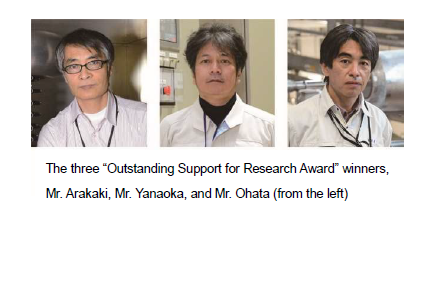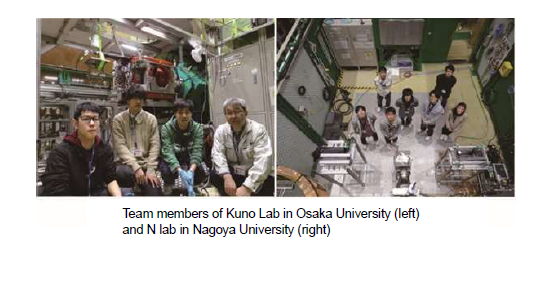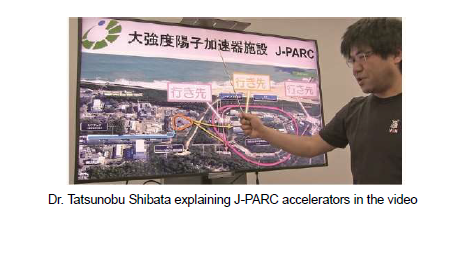J-PARC News April 2020 (Issue #180)
■Strong Constraint on the Neutrino CP Violating Phase -Major Progress with Verification of the Difference in Behavior of Particles and Anti-particles was Published in Nature.- (April 16, Press Release)
T2K (Tokai to Kamioka) experiment, in which researchers observe neutrinos created using the J-PARC accelerator traverse the 295 km to the detector Super-Kamiokande located in Kamioka-cho, Gifu Prefecture. The new results obtained from the experiment were published in Nature.
At the birth of the universe, an equal number of particles and anti-particles (particles with the same mass and lifetime but electrically opposite properties) were created. Later, the particles and anti-particles came in contact, releasing light and disappeared. However, in the present universe, only matter composed of particles survived, and anti-matter, composed of anti-particles, is hardly found. It is believed that this is due to a slight difference in the properties of particles and anti-particles. In order to confirm this, the researchers have conducted the T2K experiment, trying to clarify whether neutrinos and anti-neutrinos differ in the changes (neutrino oscillations) that occur during the trip from Tokai to Kamioka.
The CP violating phase, which indicates the difference between the properties of particles and anti-particles, can theoretically take any value from -180 degrees to 180 degrees, but the actual value is unknown. If this value is 0 or 180 degrees, there is no difference in the properties of the particles and the anti-particles. This time, the research group confirmed that with a 99.7% confidence level, this value did not exist within the range of -2 to 165 degrees. With further research, if the value of 180 degrees can be excluded, it would be confirmed with a 99.7% confidence level that there is a difference in the properties of matter and anti-matter from neutrino oscillations (CP symmetry is violated).
J-PARC has begun to upgrade the accelerators, neutrino beamline, and neutrino near detectors to increase the number of neutrino particles it produces, accumulate more data, and improve the measurement accuracy. In the future, the next-generation detector, Hyper-Kamiokande, will be used to fully understand the nature of elementary particles and the mystery of the anti-matter disappearance from space. For details, please refer to following article. http://j-parc.jp/c/en/press-release/2020/04/16000517.html

■Three J-PARC Center Engineers Received the Outstanding Support for Research Award in The Field of Science and Technology of FY2020, Given by The Minister of MEXT.
Three members of J-PARC, Mr. Yoshitsugu Arakaki (KEK Specialist) and Mr. Eiichi Yanaoka (KEK Engineer) from Accelerator Section VI and Mr. Hirokatsu Ohata (KEK Engineer) from the Cryogenics Section, were awarded the "Outstanding Support for Research Award" in the Science and Technology field of FY2020 by the Minister of MEXT. This award is given to those who have made outstanding technical contributions in the promotion of research and development. Mr. Arakaki and Mr. Yanaoka were recognized for their "contribution to the slow extraction and upgrading of the high-intensity proton beam," and Mr. Ohata was recognized for his "contribution to neutrino experiments through the construction and operation of the large scale cryogenic system." The achievement by Mr. Arakaki and Mr. Yanaoka involved an electrostatic septum, bump magnets, and trajectory control for proton beam extraction (slow extraction) from the J-PARC Main Ring (MR) to the Hadron Experimental Facility.
The achievement by Mr. Ohata involved the construction and operation of the large-scale cryogenic system that supplies cryogenic helium to a superconducting magnet system installed in the primary beamline after proton beam extraction (fast extraction) from the MR to the Neutrino Experimental Facility. They are both significant achievements for J-PARC.

■The Relationship Between Metal Ions and Water in Biological Membranes -Approach with the Quasi-elastic Neutron Scattering- (March 30, Press Release)
How metal ions and water are involved in the functions of biomolecules is an important research topic. Quasi-elastic neutron scattering is a technique that examines the dynamic state of molecules and molecular populations by detecting the small energy change of neutrons before and after scattering by a material. J-PARC Professor Seto (KEK) and his colleagues used the DNA, a bimolecular dynamics spectrometer of J-PARC, to examine how water molecules bind to phospholipids in the water when they form a bilayer with the hydrophilic groups on the water side. Phospholipids are used in various types of fundamental research as model materials for biological membranes. The result showed that there were three types of hydration water: tightly bound water, loosely bound water, and free water. Also, while the number of "tightly bound water" molecules changed depending on the binding site of the metal ions at the phospholipid membranes, the number of "loosely bound water" molecules remained unaffected. This result suggests that metal ions are not involved in the formation of "loosely bound water," and that it was determined by the properties of the hydrophilic group of phospholipids. This finding should help understand the state of water molecules that bind to the surface of biocompatible polymers, which are used as a coating for the surface of medical materials, such as the cardiopulmonary support and artificial blood vessels. It is expected to lead to the development of medical materials.

■Senior Students from Osaka University and Nagoya University Conducted Their Senior Research Projects at J-PARC! (April 17, J-PARC Website)
Typically, undergraduate students take a part of the research theme of their academic mentor in their thesis for graduation. Even so, some senior undergraduate students formed a team, decided to start research on their research theme and planned the experiments to write thesis. For such enthusiastic students, Professor Yasuhiro Miyake of J-PARC (currently a special Professor at KEK) launched an internship system 3 years ago. In January of FY 2019, senior undergraduate students from 2 universities conducted their research projects using the advanced experiment facilities of J-PARC.
The student team of Kuno Laboratory in Osaka University performed research to see the possibility of neutrinos being Majorana particles (fermions that are their own anti-particles) by searching a phenomenon in which a μ+ (positive muon) is created by a reaction of μ− (negative muon) and a nucleus. Similarly, another student team of N Lab (High Energy Particle Physics Laboratory) in Nagoya University also performed their research to observe whether decay of a positive muon creates a light particle and a positron which is not known to occur in the "standard theory" of particle physics. For both teams, this is their first experiment in such advanced large-scale facility. Although both teams were eagerly prepared in advance, unexpected situations rose from lack of thorough preparation and communication. They had to learn how to respond flexibly to such situations. Having this as a learning experience, the students started their master's program in April and began participating in advanced research. It will be exciting to know what those students will bring in the future.

■Special Video Class "Introduction to the J-PARC Accelerator" -Let's Learn about Accelerators by Using a Gaussian Accelerator!- (March 19, J-PARC Website)
In response to the spread of the novel coronavirus infections, school closures are happening all over Japan. The Japan Association of Communication for Science and Technology (JACST), formed by public relations officials of universities and research institutions nationwide, has established a website for elementary, junior high, and high school students who are spending a lot of time at home. The website offers a collection of videos from various public relations materials of the institutions, which are “great for kids."
https://sites.google.com/view/jacst-for-kids/ (Japanese only)
At the J-PARC Center, Dr. Tatsunobu Shibata (KEK Associate Professor) from Accelerator Section V, produced an exclusive lesson video “Introduction to the J-PARC Accelerator - Let's Learn about Accelerators by Using a Gaussian Accelerator!” to explain accelerators in an easy-to-understand manner. This new video and other related content are available for viewing on the website.
http://j-parc.jp/c/topics/2020/03/19000493.html (Japanese only)

